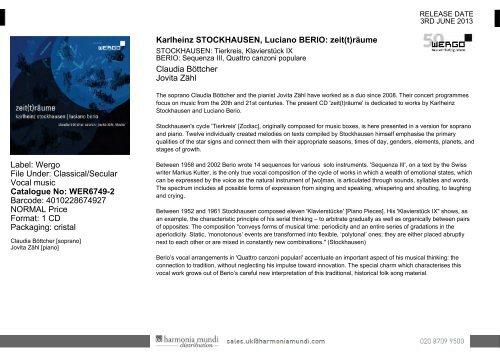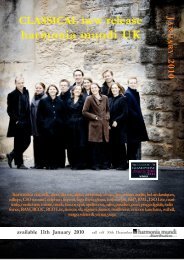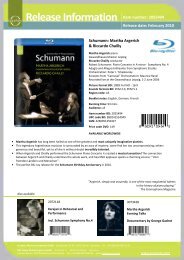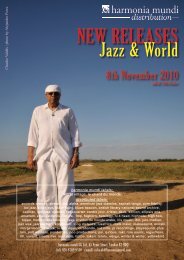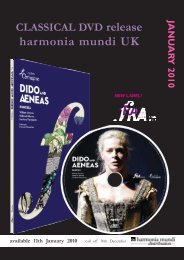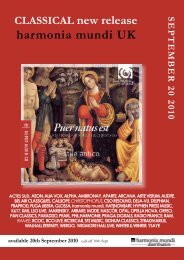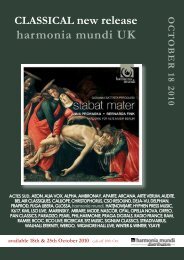Classical new release - Harmonia Mundi UK Distribution
Classical new release - Harmonia Mundi UK Distribution
Classical new release - Harmonia Mundi UK Distribution
Create successful ePaper yourself
Turn your PDF publications into a flip-book with our unique Google optimized e-Paper software.
Label: Wergo<br />
File Under: <strong>Classical</strong>/Secular<br />
Vocal music<br />
Catalogue No: WER6749-2<br />
Barcode: 4010228674927<br />
NORMAL Price<br />
Format: 1 CD<br />
Packaging: cristal<br />
Claudia Böttcher [soprano]<br />
Jovita Zähl [piano]<br />
Karlheinz STOCKHAUSEN, Luciano BERIO: zeit(t)räume<br />
STOCKHAUSEN: Tierkreis, Klavierstück IX<br />
BERIO: Sequenza III, Quattro canzoni populare<br />
Claudia Böttcher<br />
Jovita Zähl<br />
RELEASE DATE<br />
3RD JUNE 2013<br />
The soprano Claudia Böttcher and the pianist Jovita Zähl have worked as a duo since 2008. Their concert programmes<br />
focus on music from the 20th and 21st centuries. The present CD 'zeit(t)räume' is dedicated to works by Karlheinz<br />
Stockhausen and Luciano Berio.<br />
Stockhausen's cycle 'Tierkreis' [Zodiac], originally composed for music boxes, is here presented in a version for soprano<br />
and piano. Twelve individually created melodies on texts compiled by Stockhausen himself emphasise the primary<br />
qualities of the star signs and connect them with their appropriate seasons, times of day, genders, elements, planets, and<br />
stages of growth.<br />
Between 1958 and 2002 Berio wrote 14 sequences for various solo instruments. 'Sequenza III', on a text by the Swiss<br />
writer Markus Kutter, is the only true vocal composition of the cycle of works in which a wealth of emotional states, which<br />
can be expressed by the voice as the natural instrument of [wo]man, is articulated through sounds, syllables and words.<br />
The spectrum includes all possible forms of expression from singing and speaking, whispering and shouting, to laughing<br />
and crying.<br />
Between 1952 and 1961 Stockhausen composed eleven 'Klavierstücke' [Piano Pieces]. His 'Klavierstück IX" shows, as<br />
an example, the characteristic principle of his serial thinking – to arbitrate gradually as well as organically between pairs<br />
of opposites: The composition "conveys forms of musical time: periodicity and an entire series of gradations in the<br />
aperiodicity. Static, ‘monotonous’ events are transformed into flexible, ‘polytonal’ ones; they are either placed abruptly<br />
next to each other or are mixed in constantly <strong>new</strong> combinations." (Stockhausen)<br />
Berio’s vocal arrangements in 'Quattro canzoni populari' accentuate an important aspect of his musical thinking: the<br />
connection to tradition, without neglecting his impulse toward innovation. The special charm which characterises this<br />
vocal work grows out of Berio’s careful <strong>new</strong> interpretation of this traditional, historical folk song material.


